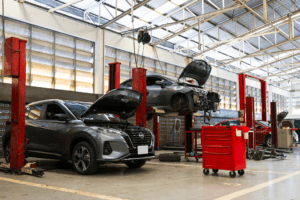Stellantis Had a Record Year in 2022

Photo: Bill Pugliano (Getty Images)
Stellantis shattered expectations, Carvana has a glimmer of hope again, and Tesla’s decision to focus battery production in the United States is one of many that’s making Europe very nervous. All that and more in The Morning Shift for Wednesday, February 23, 2023.
1st Gear: Stellantis Made So Much Money
Ancient muscle cars, ancient SUVs and ancient Italian unreliability: These are the criticisms typically levied at Stellantis, the third-largest automaker globally that, at least here in the States, is often counted out as the underdog behind its domestic rivals.
Maybe it shouldn’t be. Whatever it’s doing is working, as Stellantis announced stellar results to cap 2022. The company raked in $18 billion in net profit last year — good for a record 26-percent increase — enabling it to issue a $1.6 billion share buyback as well as up to about $15,000 to every United Auto Workers-represented employee in the U.S. From Automotive News:
The automaker, which doesn’t disclose quarterly results under French financial reporting rules, on Wednesday said net profits for the year surged 26 percent to 16.8 billion euros ($17.9 billion) while global revenue rose 18 percent to 179.6 billion euros ($190.9 billion).
North American results paced the company’s 2022 gains. Stellantis said North American adjusted operating income rose 23 percent to 13.9 billion euros ($14.8 billion). Revenues surged 23 percent to 85.5 billion euros ($90.9 billion). Deliveries rose 2 percent to 1.86 million vehicles.
In the U.S., Stellantis will distribute $14,760 each to eligible UAW-represented workers as part of a profit-sharing plan. About 40,500 workers are eligible for the bonus. The payout is up slightly from 2021, when workers received $14,670 each.
General Motors’ unionized workers will receive a profit-sharing bonus of up to $12,750 based on the company’s North American performance last year, while UAW members at Ford Motor Co. are getting an average of $9,176.
For reference. GM’s net profit on last year was $9.9 billion, while Ford lost $2 billion. All of the regions in which Stellantis plays grew last year, even though shipments lagged in the latter half of 2022 due to supply-chain constraints. Nevertheless, this strong performance has encouraged the company to be bullish entering 2023, where it predicts a “double digit adjusted operating income margin and positive industrial free cash flow,” according to the Detroit Free Press. Much like every sports team ever, you have to think Stellantis likes being the underdog.
2nd Gear: ‘Squishy’ Days Ahead for Carvana
Look — I’m not an economist, so I don’t know what that means. Generally speaking though, squish is not a desirable quality in just about any context, and it isn’t in terms of Carvana’s finances, either. The good news is that the company’s stock price has trended upward over the past two months, leading some to believe it might just be able to stave off bankruptcy. The bad news is that we’re still talking about Carvana, and old fears die hard. From Automotive News:
The online used-vehicle retailer, which is scheduled to release fourth-quarter and full-year 2022 earnings Thursday, saw its stock share price double from $5 in mid-January to $10 by month’s end. That upward movement has been driven in part by investors who believe recent upticks in used-vehicle prices and demand may bode well for the company in the first quarter, according to analysts.
Wells Fargo equity analyst Zachary Fadem wrote in a Friday note to investors that while Carvana’s improved share price performance “suggests investors are moving past the most draconian bear case” of bankruptcy, 2023 “still looks squishy” for the retailer. The firm on Friday raised its price target for Carvana from $5 to $10.
Fadem wrote that Carvana’s fourth-quarter vehicle sales are likely to fall short of Wall Street expectations. Concerns about Carvana’s liquidity and how much gross profit it brings in per vehicle sold are likely to linger, he added.
In a research note Thursday, Piper Sandler analyst Alexander Potter wrote that slashed estimates are forcing the firm’s price target for Carvana to $21 — down from $45 — but the firm does not think Carvana will go bankrupt.
Over the past couple of years, Carvana has demonstrated an uncanny knack for hanging on just when you think that last finger is about to slip off the ledge. Who knows what’ll happen next, but one thing’s for sure — it’s going to be squishy.
3rd Gear: Everyone Follows Toyota
When Toyota raises its base salary in Japan, every other Japanese company takes note. The automaker just agreed to a demand from its union to increase pay by the largest amount in two decades, per Reuters:
The automaker’s incoming president Koji Sato said the decision to accept the union’s demands in full at the first round of talks was meant not just for Toyota but “also for the industry as a whole, and in the hope that it will lead to frank discussions between labour and management at each company.”
Within hours of Toyota’s announcement, rival Honda Motor Co Ltd said it had agreed to union demands for a 5% pay increase. The average monthly base salary rise of 12,500 yen ($92.70) at Honda is the biggest jump since at least 1990.
Toyota and the union federation representing 357,000 Toyota group workers said the base pay rise was the biggest in two decades, though they both declined to provide the percentage increase.
With inflation running at around 4% – the highest level in 40 years following decades of deflation – Japan is under more pressure than ever before to raise wages to revive consumption.
Toyota’s union requested monthly base salary raises ranging from 3,570 yen ($26.53) to 9,370 yen ($69.63) based on position, according to Nippon.com. The automaker has accepted the union’s proposal for three years in a row now. Unfortunately, the rather dire state of the Japanese economy means that the only companies that will likely raise pay are firms of Toyota and Honda’s scale — and you really can’t get any bigger than Toyota.
4th Gear: Europe Knows Tesla Knows Where it’s Building Batteries
A little bit in Germany, but mostly in the U.S. From Reuters:
Tesla Inc has begun assembling batteries in Germany but will focus cell production in the U.S. in light of Inflation Reduction Act tax incentives, a spokesperson said, one of the first firms to declare a strategy shift prompted by the package.
The U.S. electric-vehicle maker is also preparing to produce cell components such as electrodes, some of which will be sent from its site in Gruenheide in the state of Brandenburg, to the United States, the Tesla spokesperson said on Wednesday.
Cars produced at the Brandenburg site would in the “near future” contain batteries assembled locally, the spokesperson added.
“The focus of Tesla’s cell production is currently in the United States due to the framework created by the United States Inflation Reduction Act (IRA),” the company said.
Two big takeaways. First, Tesla has a spokesperson? Second, European lawmakers and trade groups are rightly worried that the Inflation Reduction Act will steal manufacturing from the region and send it to North America instead, and they’ve been making much more noise about it as of late, as the Financial Times pointed out over the weekend:
“Our most important trading partner decides things in their own interest,” said Luisa Santos, deputy director-general of BusinessEurope, which represents companies across the EU. “They keep doing this. But they want us to support them on China.”
This panic will likely result in a slight boost in local subsidies on the continent, but the nature of the European Union means it can’t quickly dole out cash in the same way the Biden administration is planning to, lest the largest member states with the deepest pockets share their wealth.
5th Gear: Also, the Netherlands Won’t Fine Tesla for its Cameras
The Dutch Data Protection Authority was mulling over issuing Tesla a fine for its Sentry Mode that records all activity around the brand’s cars for security reasons. The automaker appears to have avoided the fine by making Sentry Mode activate in a way that’s more obvious to passersby, per Reuters:
Tesla uses such cameras in its cars to help owners protect them against theft or vandalism, but the Dutch Data Protection Authority (DPA) investigated them as a potential violation.
“Many Teslas parked on the street were often filming everyone who came near the vehicle, and these images were being saved for a very long time. If every car were to do that, we’d have a situation where no one could go anywhere in public without being watched,” said DPA board member Katja Mur in a statement.
Tesla could not immediately be reached for comment.
The agency said Tesla had made changes to its “Sentry Mode” feature in which the cameras are activated since the DPA investigation began. These include the cars’ headlights flashing to indicate to passers-by that filming has begun and requiring approval from the car’s owners in order to begin filming.
Films are stored in the car, and not shared with Tesla, the DPA said.
The Dutch Data Protection Authority has since decided that Tesla owners, rather than the company itself, will shoulder the blame going forward for any instances of “improper filming.” This is amusing if for no other reason than dashcams have been a thing forever, but nobody really cared about cars being vessels for public surveillance until Tesla built the feature into its products.
Reverse: Lee Petty Makes History
It was on this day in 1959 — 64 years ago — that Lee Petty won the first Daytona 500, per History.com:
On February 22, 1959, Lee Petty defeats Johnny Beauchamp in a photo finish at the just-opened Daytona International Speedway in Florida to win the first-ever Daytona 500. The race was so close that Beauchamp was initially named the winner by William France, the owner of the track and head of the National Association for Stock Car Auto Racing (NASCAR). However, Petty, who was driving a hardtop Oldsmobile 88, challenged the results and three days later, with the assistance of news photographs, he was officially named the champ. There was speculation that France declared Beauchamp the winner in order to intentionally stir up controversy and generate publicity for his new race track.
Although the news media and fans may not have realized it at the time, this would spark a long association between the France family and the phrase “generate publicity” that continues to this very day.
Neutral: Where Did This Come From?
Image: Hyundai
I still deeply believe that the Ioniq 6 is ugly, but I’ll say this: Having seen one of the press images of the back that Hyundai has released, I love that there’s a car that isn’t a Porsche with a double spoiler in 2023, and it happens to be a freakin’ family sedan. The person on the design team responsible for this idea deserves a raise. The inexplicable classic Porsche influence doesn’t stop there — the vertical reflectors flanked by silver trim instantly echo the original 911’s rear bumper and license plate surrounds in my brain.



